When There’s No Water…
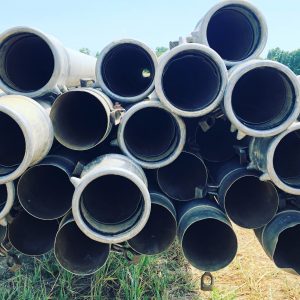
Metal pipes like these are screwed together like a giant puzzle to bring water to our field.
Can I be honest? When the rain stops, Farmer Kurt turns into a little bit of a bear.
Although the lack of rain isn’t reaching dangerous levels, it sure does mess up the flow of our farm operation.
When our plants need water, everything else gets put on the back burner. That means harvest, weeding, planning, seeding, farmer’s market board meetings, and yes… even sleep.
We’re lucky. We actually have a water source on the farm. Some farms don’t.
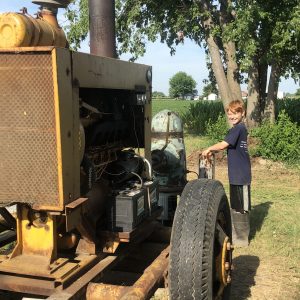
Jed knows how to operate the engine that powers the well. This is often one of his chores.
In fact, this spring, we invested some capital in digging an underground water line and creating two new water outlets near the high tunnel. This will prevent us from having to drag long hoses out when we need to water transplants.
So what tools does a farmer have up his sleeve when it comes to irrigating the fields? Let’s share a few of them with you here.
House Well Hook-Up
Sometimes we use the hookup to our house — attach a hose and sprinkle the beds in our back garden from the well in our backyard. These hoses are attached to upright sprinklers standing on the top of rebar, which waters about 4 beds at a time. This method is limited to vegetables in close proximity to our house.
We also use this house well to water all the transplants in the greenhouse, wash the crops in the washer/conveyer. and water the high tunnel crops using a sprinkler system mounted above.
The beds out in the field though are another story. Here we have three options:
Overhead Irrigation
This method is pretty labor intensive in comparison. It involves manually hauling large 30 ft sections of aluminum pipe into the field along the row we want to irrigate, then fitting them together like a puzzle, then connecting them to our parent’s well on the far end of the field.
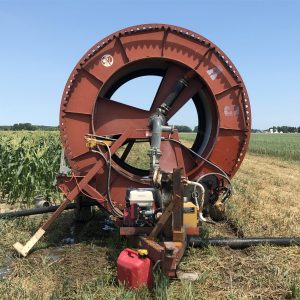
This is what the water wheel reel looks like.
This pipe then fits onto a water wheel reel. Picture a giant wheel winded up with black hose. This hose pulls out to the end of a bed row. On the end of this hose we mount a sprinkler unit that shoots out high pressure water and waters the field. The reel slowly pulls the head back into itself, so that the entire length of the field can be watered.
The problem with this system is that a lot of the water evaporates before it gets to the plant root zone. More importantly, it requires a lot of oversight. Kurt has to keep an eye on the sprinkler head to make sure it’s operating properly. And when it’s time to water the next block of crops, you have to take the whole pipe apart, move it over, and screw it back together again, and repeat.
Watch a video of the water wheel in action here.
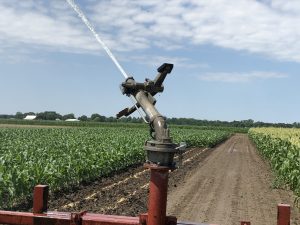
This irrigation head is slowly pulled in by the water wheel.
This method is used primarily for sweet corn. And for the last 2 weeks, Kurt has been sleeping every few nights in the truck “keeping his eye on” the irrigation pivot. This explains why he’s been so tired (and a little big edgy if you’re been working here).
Although this irrigation system allows us a lot of flexibility (because you can move it anywhere) it does sometimes create some tension between farms. I’m not gonna lie… it’s hard having to “wait in line” and not be able to water your veggies exactly when you want.
We are very fortunate to have a well nearby, It sits on our parent’s land next door about 1/4 mile. This well is 300 feet deep, and can push out water at a rate of 300 gallons a minute. It was drilled by Kurt’s grandfather, and it’s a good thing he did, because without it, our farms would be toast!
We think about water access a lot for estate planning purposes… maintaining access to that well next door is a high priority to us, and it will likely be the #1 reason we decide to purchase that land when our parents stop farming some day.
Drip Irrigation
When we first lay down the plastic-mulch covering the beds in the spring, we simultaneously lay plastic hose down the middle of the bed. This hose lies about 2 inches under the soil and is perforated, so that the water “drips” out in a controlled fashion over a 30-60 minute time frame.
The tip of the hose has a valve to open or close the line and sticks out at the end of the bed row. Each of these hose tips connects to a larger, reusable blue “fireman hose” that runs perpendicular to the beds. Water is then fed into this larger hose from either a giant tank sitting on the back of a wagon (powered by a pump), or the high pressure well located next door on our parents’ property.
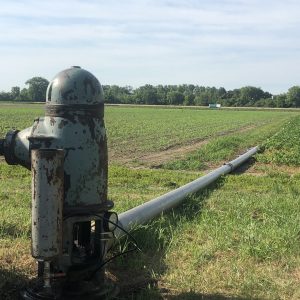
The pipes run all the way to our well on our parent’s property next door.
Drip irrigation is the preferred way to water many plants because the plant receives water slowly over a longer period of time, and can use it better. Plus it’s easy to do. You just turn on a switch and the water flows. When you’re done, you turn it off. The work comes on the front end, setting up the irrigation system around the fields, and perhaps moving the giant aluminum pipes to be able to connect them to the blue fireman hose.
Water Tank
Sometimes when we’re waiting for access to the main well, we use the next best thing… we fill up a giant water tank with water and then plug it in to the drip irrigation line somewhere in the field. We turn on a mobile engine that pumps this water at a prescribed rate into the lines.
Water Security
Water security is a liability for us and will surely become an issue for every farmer in the future. As fresh water becomes more and more scarce for our communities and the world, questions will likely come up as to who “should” get water privileges first, how much, who really needs it, what should be watered first and how much, etc.
Kurt and I have started talking about what we can do to insure a water source for our farm 20 years into the future, and developing a water plan. This will include things like using water more efficiently, and implementing cutting edge water capturing/storage technologies.
Is CSA the Right Fit for You?
Download our Guide "6 Questions You Should Ask Before You Join a CSA" to help you figure out if you're a good fit for our veggie box membership.
